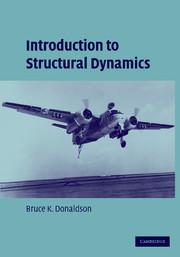Book contents
- Frontmatter
- Contents
- Preface for the Student
- Preface for the Instructor
- Acknowledgments
- List of Symbols
- 1 The Lagrange Equations of Motion
- 2 Mechanical Vibrations: Practice Using the Lagrange Equations
- 3 Review of the Basics of the Finite Element Method for Simple Elements
- 4 FEM Equations of Motion for Elastic Systems
- 5 Damped Structural Systems
- 6 Natural Frequencies and Mode Shapes
- 7 The Modal Transformation
- 8 Continuous Dynamic Models
- 9 Numerical Integration of the Equations of Motion
- Appendix I Answers to Exercises
- Appendix II Fourier Transform Pairs
- Index
- References
9 - Numerical Integration of the Equations of Motion
Published online by Cambridge University Press: 30 November 2009
- Frontmatter
- Contents
- Preface for the Student
- Preface for the Instructor
- Acknowledgments
- List of Symbols
- 1 The Lagrange Equations of Motion
- 2 Mechanical Vibrations: Practice Using the Lagrange Equations
- 3 Review of the Basics of the Finite Element Method for Simple Elements
- 4 FEM Equations of Motion for Elastic Systems
- 5 Damped Structural Systems
- 6 Natural Frequencies and Mode Shapes
- 7 The Modal Transformation
- 8 Continuous Dynamic Models
- 9 Numerical Integration of the Equations of Motion
- Appendix I Answers to Exercises
- Appendix II Fourier Transform Pairs
- Index
- References
Summary
Introduction
As discussed in the last part of Chapter 5, digital computer software capabilities have currently reached a point where numerical solutions to very large, linear, structural dynamics problems can be successfully achieved. As an indication of the growth in size of structural models being used in dynamic analyses, note that it is now not uncommon for structural dynamic analyses to employ the same detailed FEM models prepared for the purposes of static stress analyses. As a result of this marked increase in the number of DOF used in analyses, and just as importantly, as part of the clear trend toward automating everything, the integration of the equations of motion is rarely done by any means other than by digital computer-based numerical methods. Although these reasons are sufficient for looking at numerical integration techniques, there are still other important reasons. The foremost of these other reasons is that numerical integration is the only practical approach when material nonlinearities (e.g., plasticity) or geometric nonlinearities are part of the system's mathematical model.
Today, numerical integration is a well-developed field with many textbooks available to provide a comprehensive overview on both simplistic and sophisticated levels. See, for example, Refs. [9.1, 9.2]. Therefore it is appropriate for this textbook to provide only a brief introduction to the popular numerical integration techniques that are particularly suitable for the numerical integration of the ordinary differential equations that result from the modal transformation applied to a finite element model or are suitable for the direct integration of the matrix equation of motion in terms of the original generalized coordinates.
- Type
- Chapter
- Information
- Introduction to Structural Dynamics , pp. 451 - 482Publisher: Cambridge University PressPrint publication year: 2006



